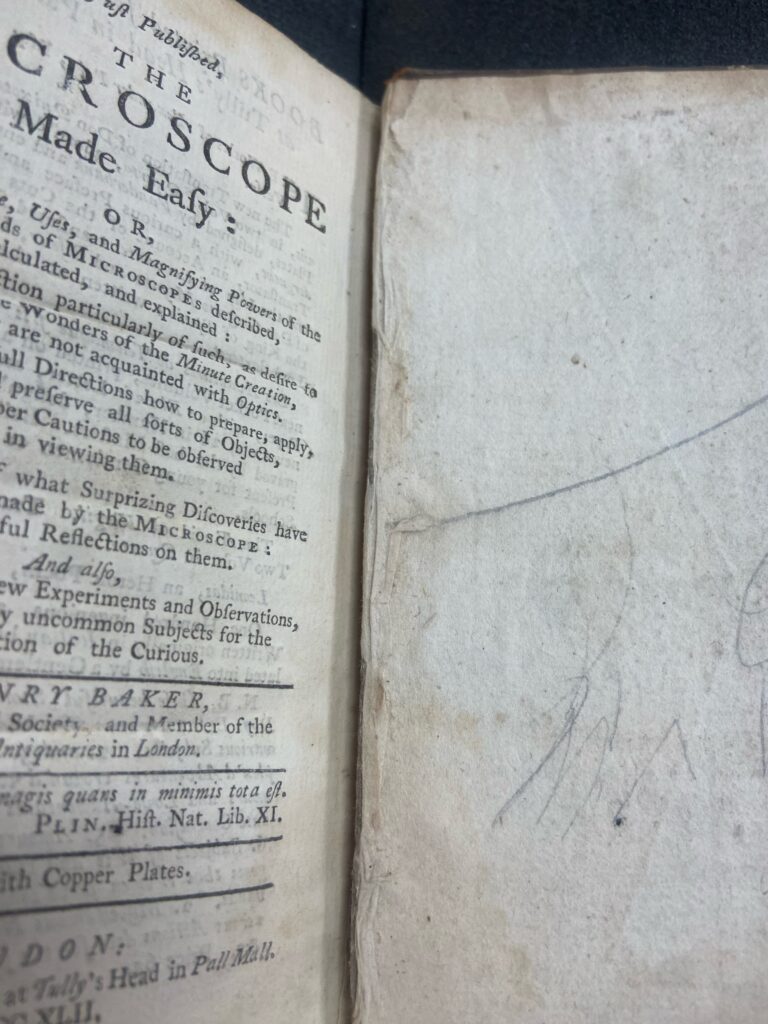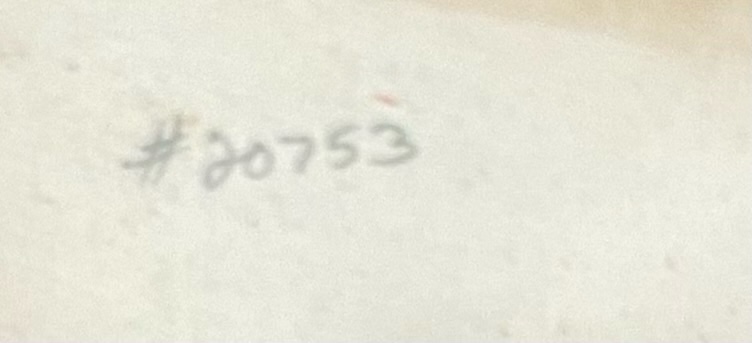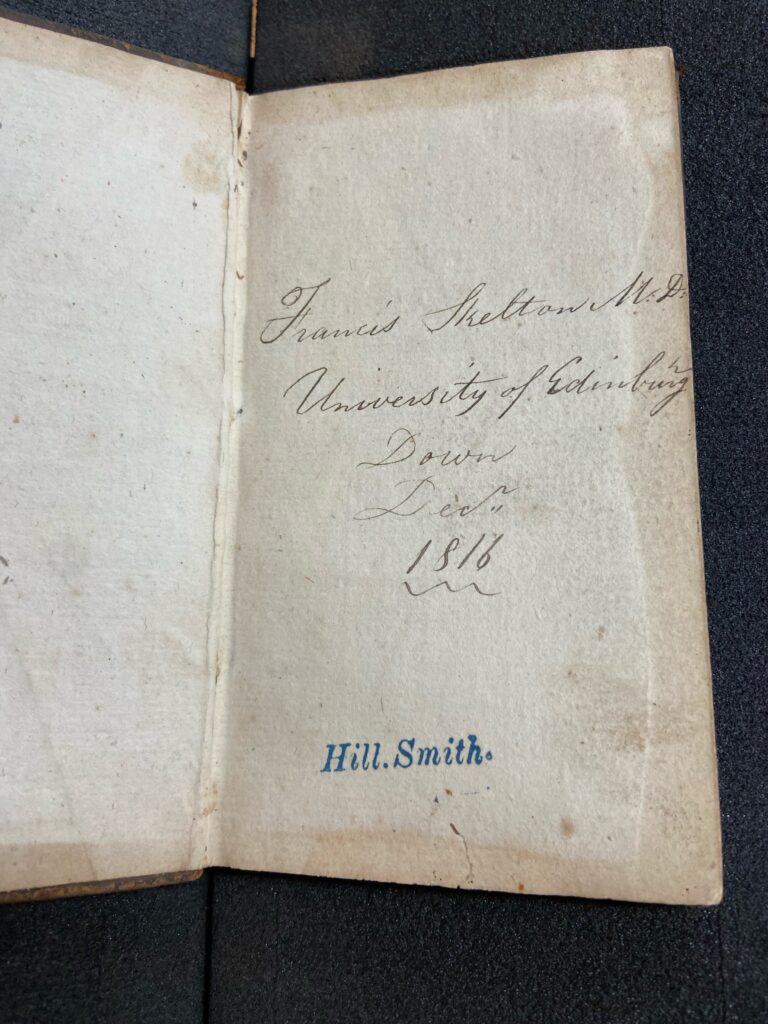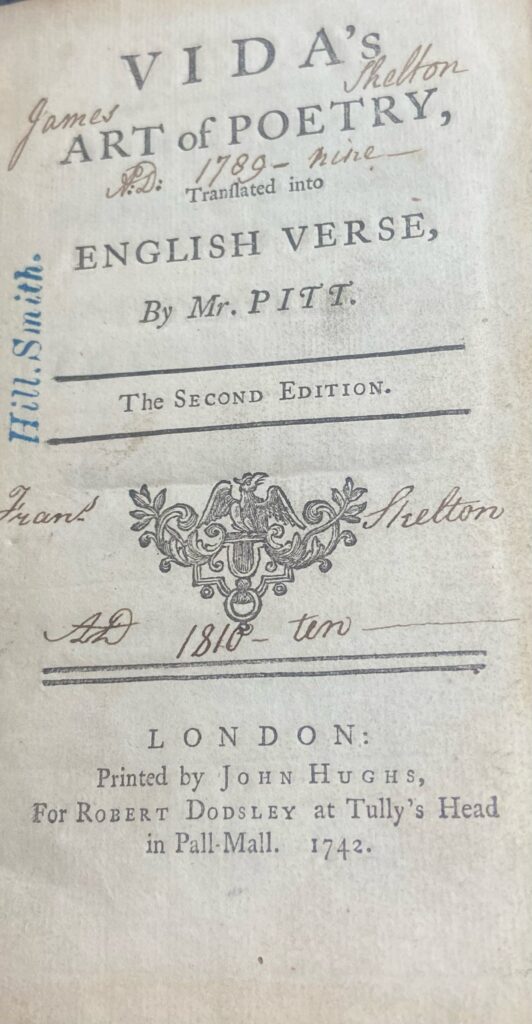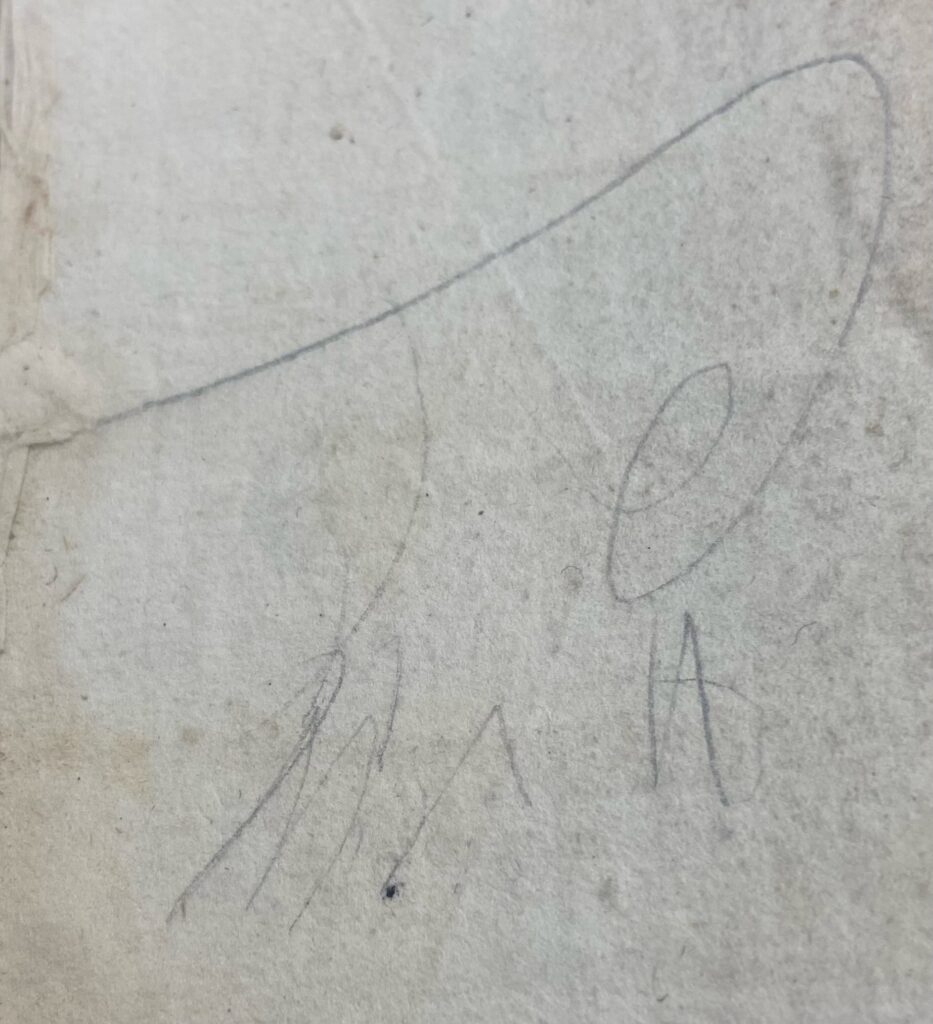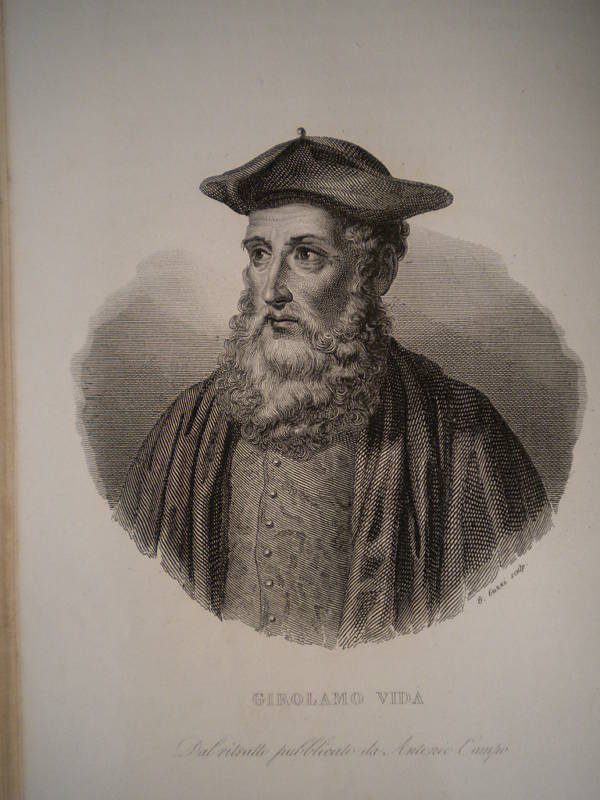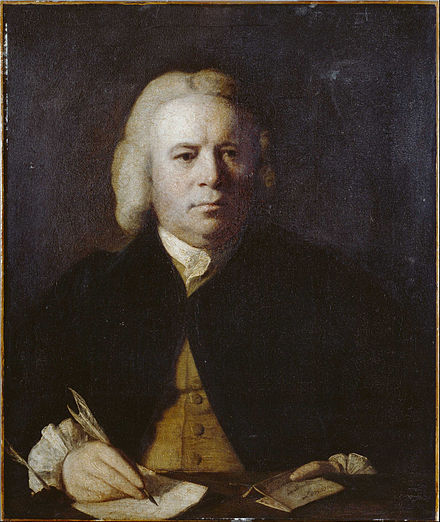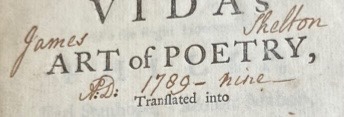The Second Edition
Printed in London by John Hughs for Robert Dodsley at Tully’s Head in Pall Mall
1742
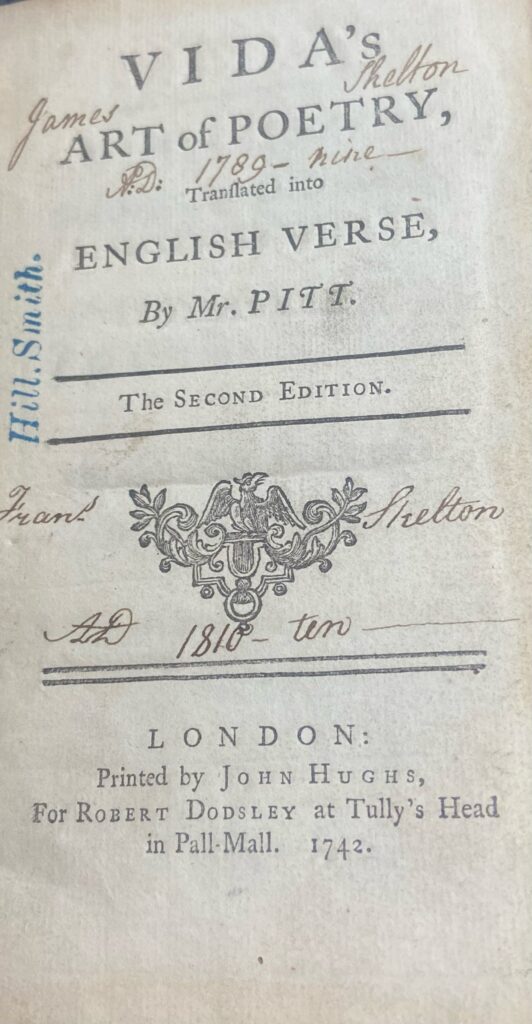
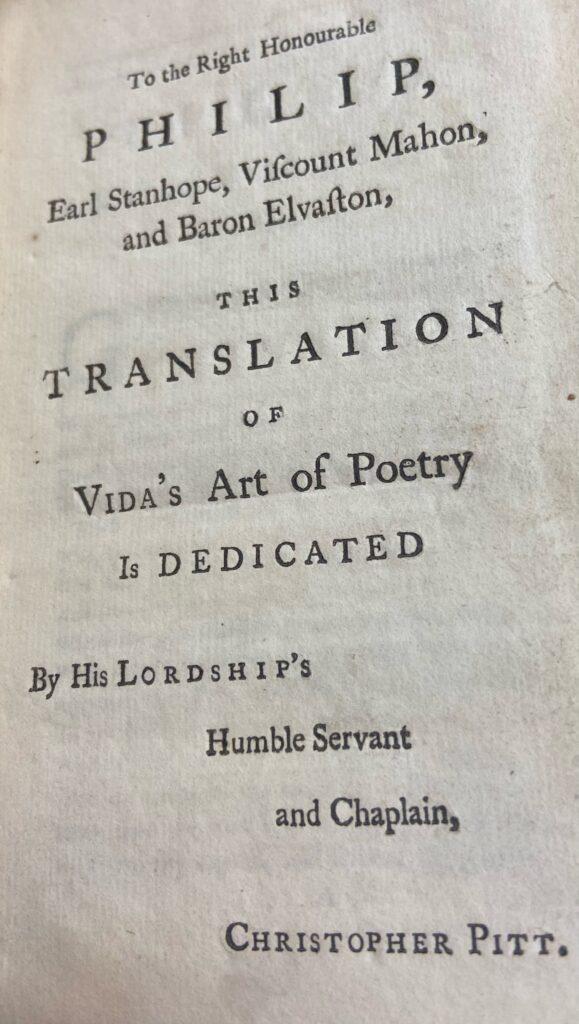
Book Identification
Author – Marco (Girolamo) Vida
Title – Vida’s Art of Poetry, Translated Into English Verse, By Mr. Pitt.
Publisher – John Hughs
Monetary Patron (Bookseller) – Robert Dodsley
Place of Publication – London at Tully’s Head in Pall Mall
Year of Publication – 1742
MSU Library Call Number – PN 1064 .V4813 1742
The Book’s Physical State
This particular copy of Vida’s Art of Poetry is in moderate condition with many signs of aging. The cover, made of calfskin, is worn and peeling, so the boards underneath are visible.
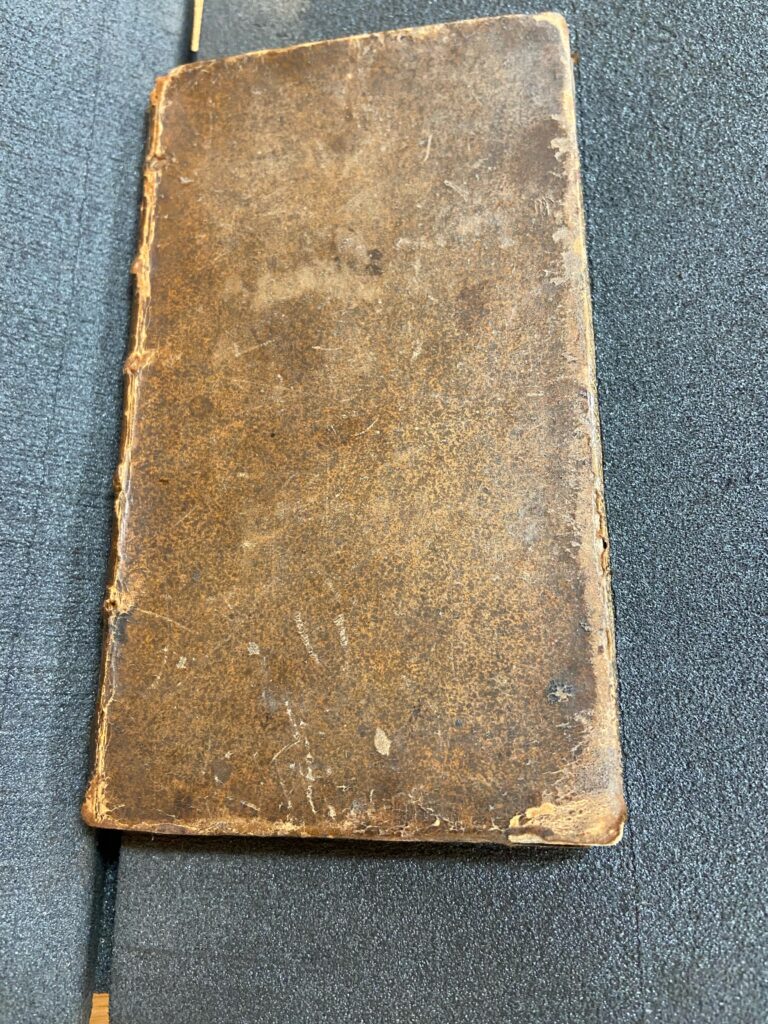
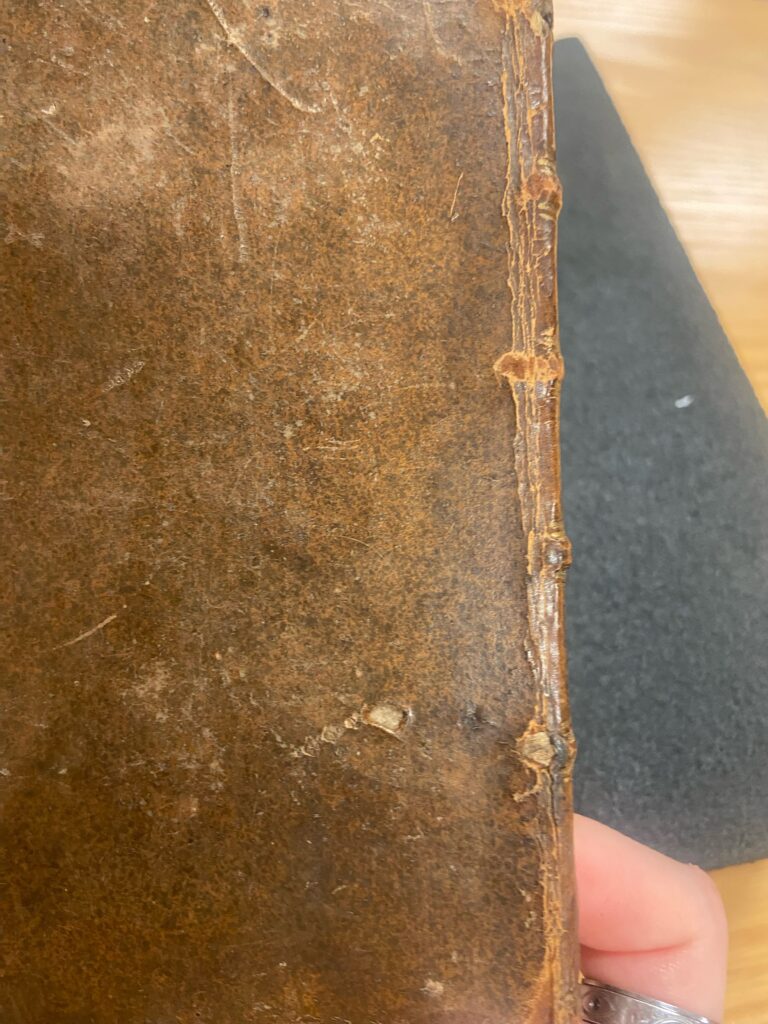
At the very beginning of the book, pastedowns and endleaves compose the first few pages. These are evident at the end of the book to secure and integrate the binding as well. One of the endleaves by the back cover of the book has been ripped out, further compromising the binding. The cracked spine of the book indicates that the book was studied multiple times. A small marking in pencil on the verso side of an endleaf in the book that reads “#20753” most likely indicates a bookseller’s number for the book.
The first discernible chronological instance of provenance within the book occurs at the top of the title page. The inscription “James Skelton A.D. 1789- nine” resides at the top of the page in between lines of the title. In a similar fashion, Francis Skelton signs his name on this same title page with the text “A.D. 1810- ten”. On one of the recto endleaves just before the title page, an inscription reading “Francis Skelton M.D. University of Edinburgh Down Deck 1816” includes another instance of provenance from this owner, indicating that Francis was in possession of the book for a number of years. These three dates and two owners with the same family name may imply that the Skelton family possessed the book from the late 18th century to the early 19th century. On a recto end leaf, a blue ink stamp reading “Hill.Smith.” also indicates provenance, perhaps from a later period, as ink stamps were not common until later parts of the 19th century. “Hill.Smith” is seen again on the next recto page, the title page, and following along the spine on the left side reads the same blue ink stamp.
Foxing appears throughout the book due to the age and repeated use of the text. Very little mark ups reside in the book except for slight markings to indicate sections of importance to one of the book’s owners, these are most likely from a single owner due to their uniformity.

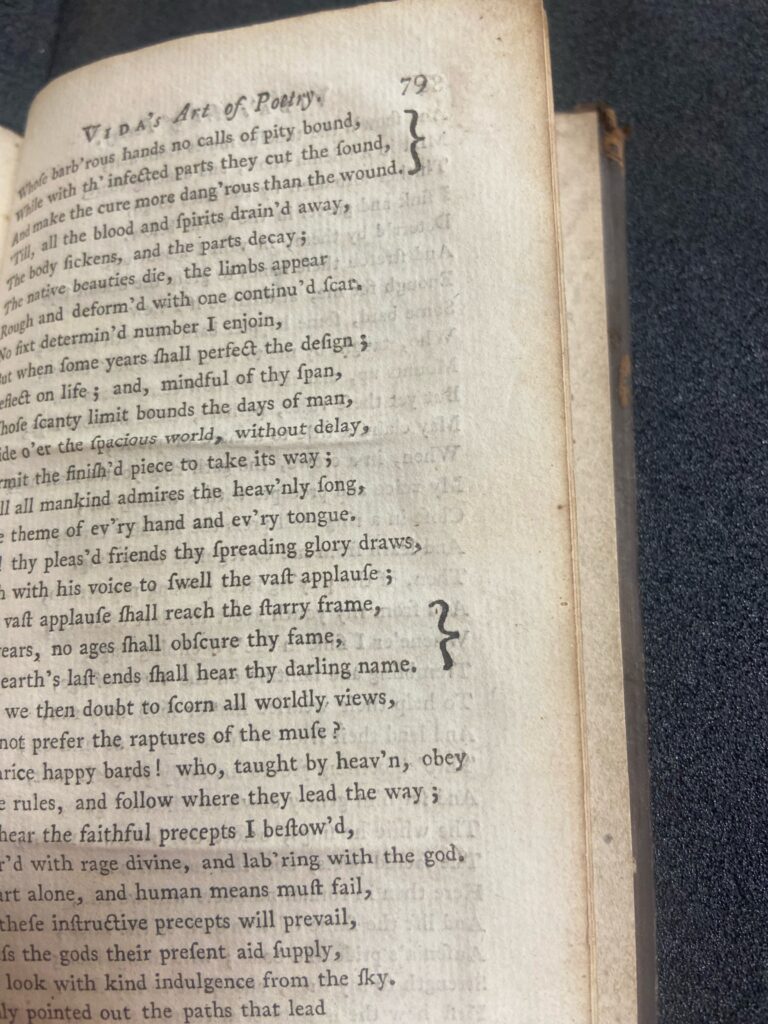
A small design of a bird sitting atop branches appears on the title page as well. At the end of the first book and at the end of the second book, a crest in the same ink as the bird design is present. It depicts a sun in the center of the crest. The final crest, indicating the end of book three, depicts a pot covered in garland. These three crests were included into the printing process and thus are not instances of provenance or a printer’s mark.
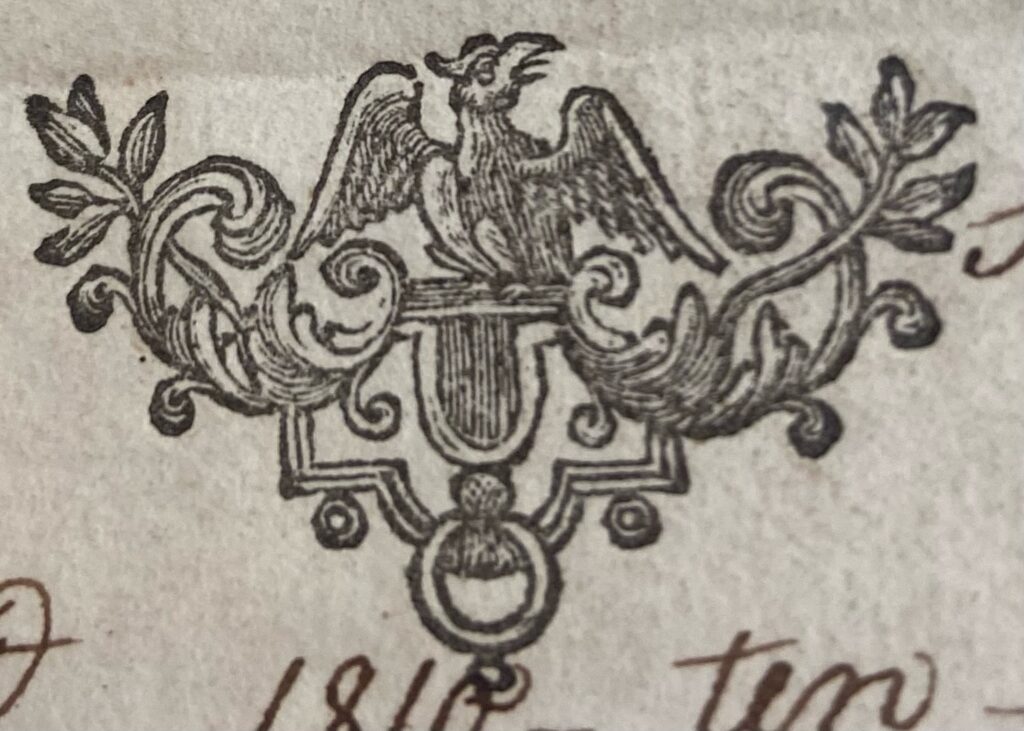
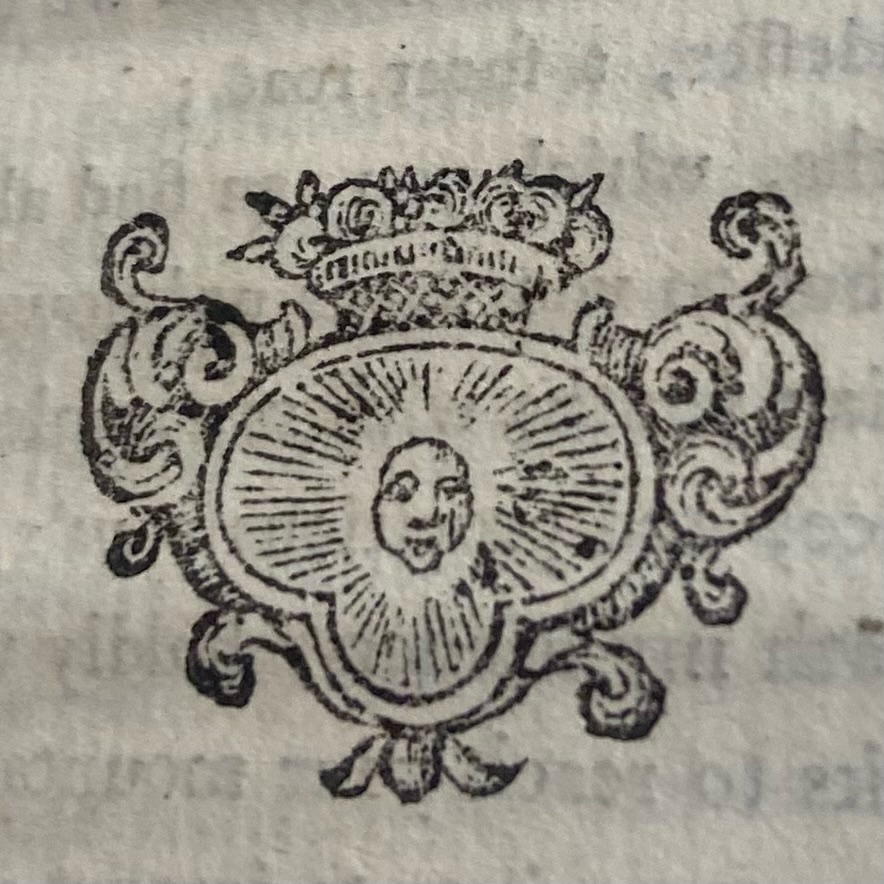
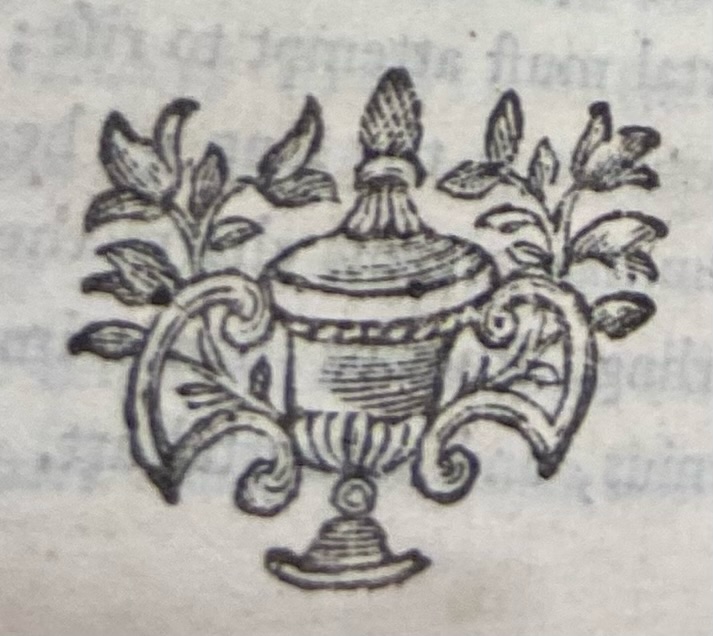
A final inclusion of provenance occurs on the back pastedown of the book, but it is illegible and looks to be someone practicing a signature or scribbling in cursive, most likely a child’s drawing. Perhaps this child was the same person responsible for ripping out an endleaf.
The Book’s Contents
Marco Vida was born in 1485 in Cremona, Italy. A very educated individual, Vida joined the court of the Church in the early 1530s. Vida was involved in controversies surrounding the war with the Spanish, which stained his relationship as part of the priesthood. He died on September 27th of 1566. Outside of religion, Vida was a neo-Latinist and a famous Italian poet instrumental in the Renaissance. He wrote De Arte Poetica (On the Art of Poetry) in the early 16th century and its original publication was in 1527. That same century, the work was translated into an Italian version, thus reaching a wider audience. The first edition of the English translation of the work was not until 1725 and only then did it gain the name Vida’s Art of Poetry.
Vida’s influences surpassed his lifetime and culture. Though originally intended for an Italian audience in Renaissance times, the book and its teachings made their way to 18th century England, allowing Greek and Latin works from centuries ago to be analyzed in a new light.
The book is a three part analytical and instructive narrative on the importance of poetry and the proper elements that a good poet incorporates into their works. A large majority of the text revolves around the successes of Virgil and the shortcomings, in comparison, of Homer. The text was important and came about in 15th century Italy due to the Renaissance and a newfound cultural importance of Latin and Greek works.
The copy of the book that the MSU library holds was translated into English by a Mr. Christopher Pitt. Pitt was born in 1699 into a very wealthy and well-connected English family. Subsequently, he gained an outstanding education that allowed him to be a clergyman, poet, and acclaimed translator. Pitt translated the novel’s text from Italian to English in 1725. His work of the translation provided him with a big reputation and allowed him to work in the clergy and in poetics as a poet and translator. He died on April 13th of 1748.
This book was published in 1742 by John Hughs for the bookseller and publisher Robert Dodsley (13 February 1703 – 23 September 1764) at Tully’s Head in Pall Mall, which was a prominent printing company in London. Dodsley published many books for the company and they were then sold off. Dodsley was one of the monetary patrons of this business, as many books that were sold from this printing company were printed for him.
One should note the vast time period in between the initial creation and the English translation with the subsequent reprinting. While the original ideas of Vida’s analysis of poetry were written down and shared with those during the Renaissance, its importance sustained throughout time as the book was well known enough for a second edition and translation into English to be made, so as to reach a wider audience.
Provenance
1742-1789
This copy of Vida’s Art of Poetry spent 50 years idle, either with no owners or an ownership with no marks of provenance.
1789
“James Skelton: A.D. 1789- nine” –
James Skelton was the first noted owner of Vida’s Art of Poetry. Born in 1763 in York, England by the name James Skelton Gilliam, he was son of Richard Skelton. James was baptized on the 22nd of September in the year 1765 when he was two years of age. In his adulthood, James Skelton traveled to Scotland to pursue a medical education. It was at this time that he came into possession of this copy of Vida’s Art of Poetry. He signed his name to it, marking the year of possession as 1789.
He earned his degree at the University of Edinburgh and later moved to Virginia, US to practice medicine as a physician. In 1814, he passed away. James Skelton was presumably an uncle or cousin on Francis Skelton’s mother’s side. When James left for the United States, the book stayed in Scotland with the Skelton family where Francis eventually picked it up and claimed ownership in 1810.
1810
“Francis Skelton (M.D.): University of Edinburgh (Down Dec. 1816)” & “Francis Skelton A.D. 1810- ten” –
Francis Skelton was born in September of 1792. He died at the age of 49 in 1841. Within his lifetime, he was a student at the University of Edinburgh in their medical school. His impressive education indicates that this intellectual book was important to the highly educated. The University of Edinburgh’s alumni records for their medical school reveal that Francis Skelton graduated in 1816 with an M.D. He received an MRCS in 1817, meaning he was a member of the Membership of the Royal College of Surgeons. This degree was a postgraduate certificate that entailed an examination. Essentially, doing well on the exam means that a person can become a member of one of the four surgical colleges in the UK and Ireland. The University of Edinburgh’s Surgical School is on this list.

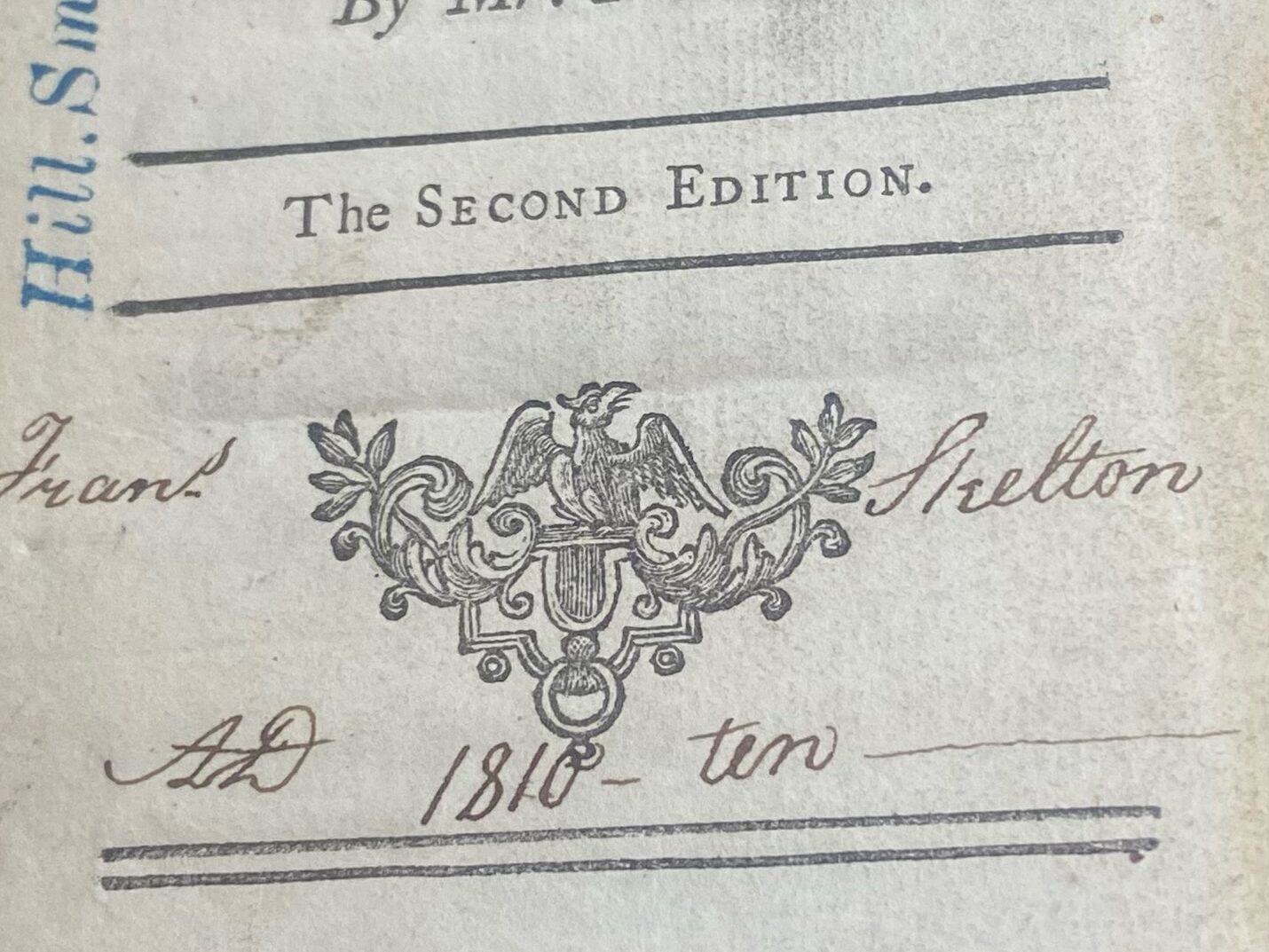
After graduation, Francis Skelton moved from Scotland to India. In 1817, Skelton received the Indian Medical Service and was listed on the UK Roll of the Indian Medical Service. The Indian Medical Service was a branch of military medicine during the world wars and throughout British occupation. Skelton received an AS on January 16th of 1817, meaning his official title was Assistant Surgeon to the forces, or lieutenant. Skelton served in British India from 1817 to 1822 and most likely worked at a civilian hospital, which was one of the most common postings. On May 18th of 1822, he resigned his position within the Indian Medical Service and moved back to Europe. That same year on October 15th, Francis Skelton began receiving pension from the Lord Clive’s Fund. The fund was a pension fund for soldiers that had served in the East India Company’s army and their spouses.
He was married to Mary Skelton in the late 1810s or shortly after his return from India in the 1820s, but there is no record of their marriage license, disallowing for an exact date. Mary Skelton was an Englishwoman born in 1774, making her almost two decades older than Francis. The couple collected the Lord Clive’s Fund pension each year, allowing them a comfortable living. In 1841, Francis Skelton passed away and was buried in St. Thomas, Southwark in Southwark, England. On April 10th of 1847, Mary Skelton passed away and was buried next to her husband. Another indication of their relationship is the date on which the Skelton’s stopped collecting pension: 1846. This date aligns with Mary’s passing as she did not survive long enough to collect the pension for 1847. There is no record of any children or descendants of these two Skelton family members, and a short time after Mary’s death, the book changed hands to the Hill-Smith family.

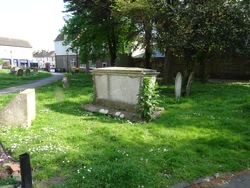
1850s
“Hill.Smith.” –
The Hill-Smith family was prominent in Scotland in the mid to late 19th century. The last name Hill-Smith was a common one in Scotland and the last name was established as a prominent family name in between 1851 to the end of the 19th century in both the UK and Scotland. The finding that this family name was common within that time period further aligns with the prominence of stamps in books, as they became popular at the same time as the last name Hill-Smith gained popularity. Within the physical copy, Hill-Smith was stamped into the book in blue ink multiple times. Perhaps the Hill-Smith family kept the book in their family library. Like the Skelton’s, the Hill-Smith family were a prominent and educated Scottish family, also making them a prime patron of an analytical poetics book translated into English. Based on time period, one can assume that the Hill-Smith family came into possession of the book after the Skelton family and the book moved from one part of Scotland to another.
1900s-now
MSU eventually purchased this copy of Vida’s Art of Poetry in the 20th century. No record of the exact date or year of this purchase has been recorded. It still remains as part of the Special Collections section of the MSU library.
Created by Graciana Rudolfi for Dr. Liam Brockey’s History of the Book course in Fall 2023
Sources
Francis Skelton – find a grave memorial. Find a Grave. (n.d.-a). https://www.findagrave.com/memorial/198750472/francis-skelton
Hill Smith Family history. Hill Smith Name Meaning & Hill Smith Family History at Ancestry.com®. (n.d.). https://www.ancestry.com/name-origin?surname=hill+smith
John Baskerville, type-founder and printer – Fifteen Eighty Four: Cambridge University Press. Fifteen Eighty Four | Cambridge University Press – The Official Blog of Cambridge University Press. (2017, March 22). http://www.cambridgeblog.org/2014/09/john-baskerville-type-founder-and-printer/
Marco Girolamo Vida. obo. (n.d.). https://www.oxfordbibliographies.com/display/document/obo-9780195399301/obo-9780195399301-0337.xml
Mrs Mary Skelton (1774-1847) – find a grave… Find a Grave. (n.d.-b). https://www.findagrave.com/memorial/180481036/mary-skelton
OpenLibrary.org. (n.d.). Printed for R. dodsley at tully’s-head, pall-mall and sold by M. Cooper in pater-noster-row publisher – 1 work / 1 ebook. The Internet Archive’s Open Library: One page for every book. https://openlibrary.org/publishers/printed_for_R._Dodsley_at_Tully%27s-head,_Pall-mall_and_sold_by_M._Cooper_in_Pater-noster-Row
Skelton family history. Skelton Name Meaning & Skelton Family History at Ancestry.com®. (n.d.). https://www.ancestry.com/name-origin?surname=skelton
“Skelton, Francis.” (n.d.). https://collections.ed.ac.uk/alumni/record/80440?highlight=%2A%3A%2A
UK, Roll of the Indian Medical Service, 1615-1930 – AncestryLibrary.com. ancestorylibrary.com. (n.d.). https://www.ancestrylibrary.com
Wikimedia Foundation. (2023a, March 13). Christopher Pitt. Wikipedia. https://en.wikipedia.org/wiki/Christopher_Pitt
Wikimedia Foundation. (2023b, September 22). Robert Dodsley. Wikipedia. https://en.wikipedia.org/wiki/Robert_Dodsley
